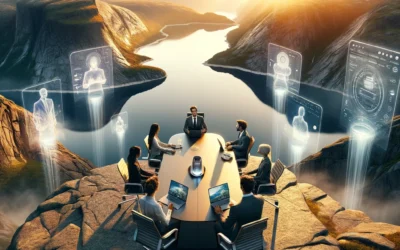Disruptive technologies are having an undeniable impact on large businesses. Most enterprises today are in the process of “digital transformation.” What they are doing initially, however, is more accurately described as a digital modernization. New technologies are introduced to improve existing businesses by elevating the customer experience and streamlining operations.
A 2017 article from McKinsey titled “The next-generation digital operating model for the digital world” makes no mention of new business models. It recommends using technology to streamline horizontal “customer journeys” across the business. Anyone who has been transferred six times when talking to customer support can appreciate the value of this, but modernizing legacy businesses is not enough.
Digital Transformation must be about more than customer experience and operations. Amazon, Airbnb, and Uber have shown how technology can fuel business model innovation and disrupt industry structures. Enterprises failing to transform their business models risk becoming the next Blockbuster, Borders, Nokia, Blackberry, or Kodak.
Corporate Venturing has become an increasingly attractive way to source innovation, but enterprises must also develop their internal innovation capability. Doing so requires overcoming obstacles to success.
Innovation efforts in existing lines of business are unlikely to disrupt their business models. Firms with employees who have all worked in the same industry invariably have blind spots. Compensating and promoting managers based on meeting near-term operating goals leads to conservative behavior. Managing existing businesses is fundamentally different from building new ones. The two functions should be segmented.
One type of segmentation is to set up an innovation outpost, which can also engage in technology scouting and Corporate Venturing. The innovation outpost develops new product concepts and prototypes, which are then “transferred” back to headquarters. Such efforts may face political resistance due to conflicting world views and incentives.
A different type of segmentation holds more promise — an independent unit dedicated to building new businesses from scratch. We refer to this type of capability as a higher-order organization. Higher-order organizations combine capital, technology, people, and a methodology to build new ventures. These can be spun out or managed as part of a portfolio of next-generation growth businesses.
Higher-order organizations can utilize outside talent, technology, and capital as well as internal resources. They treat people developing new ventures as co-founders instead of employees, allowing them to attract people who would otherwise join or found startups.
Higher-order organizations already exist outside large enterprises. Idealab in Los Angeles and Moonwalk in London are examples of firms set up as higher-order organizations from scratch. We believe such stand-alone higher-order organizations will provide an attractive new asset class for investors. (Note: The Post-Industrial Institute is an advisor to Moonwalk.)
Since most enterprises are already embracing digital modernization, the best they can achieve is not to fall behind their peers. Corporate leaders should, therefore, begin to focus more on building new businesses with disruptive business models. A higher-order organization is an engine for powering organizational renewal. It is not a replacement for digital modernization efforts, but a critical augmentation that shifts the strategic focus outward and forward.
To deliver the goods, higher-order organizations must embrace a new kind of management thinking appropriate for the world now emerging. In our February 2019 white paper “Digital Myopia: The Coming of Post-Industrial Civilization,” we argued that because of the combination of exponential technology development and massive decentralization, humanity is in a transition to a post-industrial civilization and economy. This civilization will be characterized by:
- rapid progress in AI
- automated transport and logistics systems
- automation of all routine work
- automation of most managerial tasks
- nanotech, atomic precision manufacturing
- abundant energy and computing power
- abundant information storage and bandwidth
- genetic engineering and artificial life
- a dramatic increase in human longevity
- augmenting our bodies with technology
- linking humans with AIs
- extended reality (XR), combining AR/VR with sensors in the physical world
- a shift toward decentralized and AI-managed networks of individuals and firms
- commercial space exploration and colonization
The combination of exponential technology development and decentralization has important implications for how we think about management, careers, and firms.
In his now-famous 1937 paper “The Nature of the Firm,” British economist Ronald Coase relates the existence, shape, and size of firms to transaction costs. Firms are formed because there is overhead in finding and selecting products for each transaction. Keeping some functions in-house, therefore, make sense. On the other hand, the cost of management mistakes, adding to transaction costs, increases with complexity, size, and distance. Coase helps us understand why there is a limit to how big firms can become.
Coase mentions that technologies affect these trade-offs, and cites the potential impact of the telephone and the telegraph. In our era, technologies like the Internet, the smartphone, Machine Learning, Distributed Ledgers, and the Smart Phone enable rapid creation, coordination, growth, and change of economic networks. The size of firms, Coase tells us, is a function of how many nodes in networks need to be on the inside of the firm to deliver competitive value.
Technology enables Amazon to remain a fast-moving industry disruptor in spite of more than 660,000 employees on the one hand. Amazon is continuously expanding into new industries, building new operating platforms, and finding new uses for them. Technology also allowed Instagram to create so much value that it was acquired for a billion dollars with just 13 employees.
Technological progress will contribute to us moving more functions outside the firm, and we will also link firms together more efficiently. At the same time, a firm may need to employ more people when it grows if the functions added cannot yet be automated. Amazon is an example of this. Eventually, the work done by its blue-collar workers will be automated, and Amazon will eliminate their positions. New firms will not require as many employees to create value, so we will soon see a business landscape of increasingly automated micro-organizations.
Mainstream management thinking remains infused with industrial-era ideals and assumptions. These include long-lasting firms, hierarchical organizational structures, long employee tenures, and firms as job creators. Toyota’s management system, known in the West as “Lean Enterprise,” probably represented the peak of industrial-era management thinking. It showed how firms could invest long-term in developing people as problem-solvers and through incremental innovation, create customer and shareholder value. Lean, in turn, inspired Lean Startup, a methodology for developing startups through ongoing experimentation.
The post-industrial transition brings with it a massive restructuring of entire industries, shrinking corporate lifespans, and shorter job tenures. Incremental change is no longer enough. Enterprises, investors, and policymakers are facing a world where traditional management and policy thinking has not kept up with technological change. At the Post-Industrial Institute, our mission is to develop new management thinking and tools for the post-industrial transition.
Enterprises must go beyond Digital Transformation. They must become self-renewing autonomous networks of micro-organizations. Their border with the outside world will be porous, and they will form new organizations on a just-in-time basis. Value creation will focus on reshaping industry networks to more efficiently detect and satisfy customer needs. This is the Post-Industrial Enterprise. The higher-order organization is the engine that powers this transformation.










